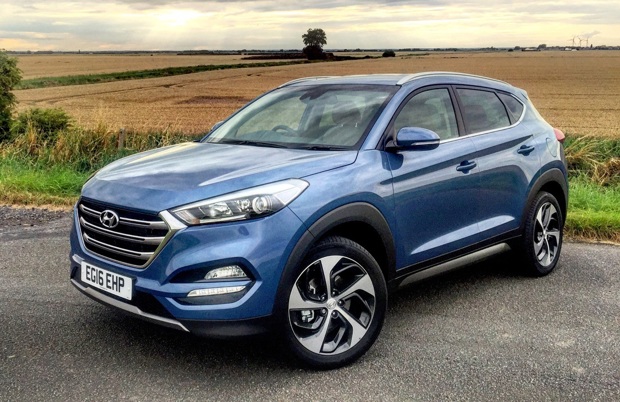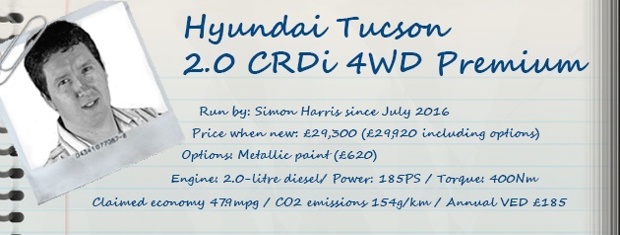Say hello to our Tucson
We welcome the Tucson to our fleet - and it's a great example of Hyundai's continual evolution.
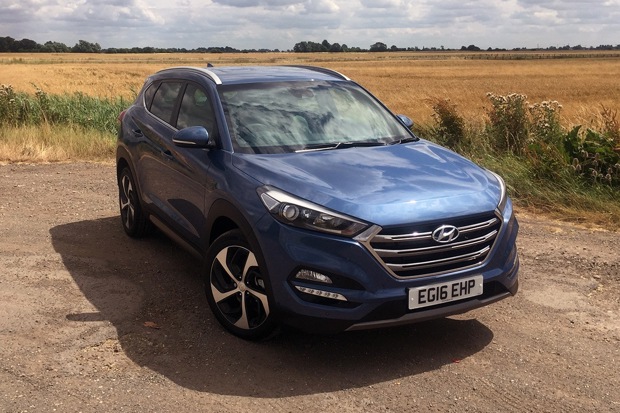
Date: 1 August 2016 | Current mileage: 880 | Claimed economy: 47.9mpg | Actual economy: 38.5mpg
Hyundai has evolved from a budget car manufacturer to a key mainstream choice in the UK over the last 20 years. In 2015 it was in the top 10 new car registrations, and it has succeeded in growing, not necessarily through exploring new model niches, but increasingly through its value proposition and eye-catching styling.
The Tucson was introduced in 2015 to replace the popular ix35, one of the most prolific ‘crossovers’ on UK roads, striking a chord with both private customers and company car choosers.
The ix35, introduced in 2010, actually replaced a car called the Tucson. Hyundai has decided that while the rest of the range uses an alphanumeric naming system, its SUVs should have names that conjure images of the great outdoors. Tucson is a city in Arizona, while Santa Fe is in New Mexico.
But most people buying these cars probably aren’t going to venture too far away from the road, so they are designed to feel comfortable in everyday driving.
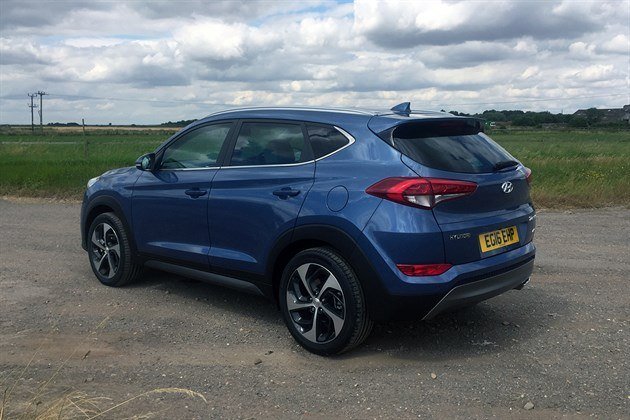
The Tucson looks classy and sophisticated
In many cases with crossovers, the line-up is designed to offer a few models that are more capable should owners need to tow, traverse muddy fields or spend a little time tackling uneven surfaces along rutted tracks.
Our latest addition to the fleet fits into the latter category. While two-wheel drive Tucsons will satisfy the needs of most owners, and the fuel-efficient Blue Drive diesels will appeal to company car drivers to help minimise their tax liability, we’ve taken delivery of a four-wheel drive 2.0-litre.
This is the most powerful version of the Tucson, producing 185PS and maximum pulling power of 400Nm is delivered from 1750rpm to 2750rpm. It should be a muscular performer on or off road as well as a relaxed motorway cruiser.
Ours is the medium equipment grade, Premium, although it’s only missing a handful of items found in the range-topping Premium SE, such as LED adaptive headlamps, ventilated front seats and a sunroof.
It does have an eight-inch touch-screen interface with navigation, leather seat facings, heated and electrically adjustable front seats, and dual-zone climate control as well as important safety equipment such as autonomous emergency braking and collision warning, blindspot monitoring and lane-keeping assistance. We look forward to evaluating the Tucson over the next six months and finding out if it is capable as an all-round family car.
Colour me impressed
The Tucson comes in surprising range of both exterior and interior colour options.
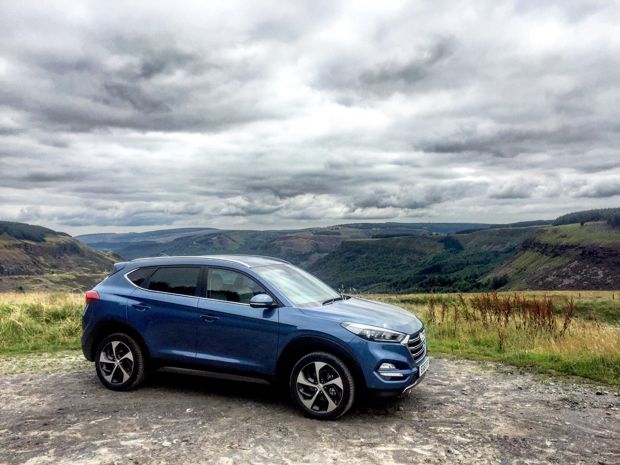
Date: 15 August 2016 | Current mileage: 2385 | Claimed economy: 47.9mpg | Actual economy: 42.8mpg
One of the things I lamented on the last car I had on test was the lack of colour choices. The Kia Sorento was available in five colours, two of which were grey and two of which were white. And the interior, while well finished, was a rather sober charcoal.
It's a different story with the smaller Hyundai Tucson, which is offered in 13 exterior shades and a choice of two interior colours. When I was selecting the particular Tucson for testing for ccars in stock in the UK, the colours available was a big influence on my decision.
Seeing a stargazer blue (the more subtle of the two shades of blue offered on the car) with a beige interior, made it much more appealing. Light coloured interiors often aren't practical and stains and grubbiness are more difficult to disguise. But this mid beige is dark enough to age well but at the same time create a far less oppressive feeling than black.
And the light colour isn't just on the seat trim and doors - it's also on the lower dashboard panels and helps enhance the car's more upmarket feel over its ix35 predecessor. It's early days, but so far doesn't seem to be difficult to keep clean.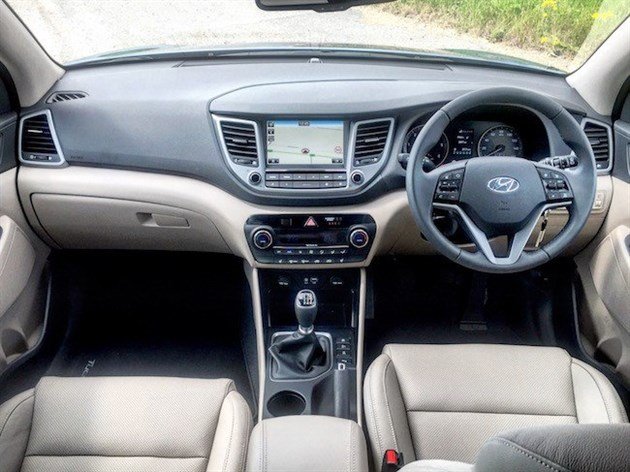
In the first report on the car, I outlined some of the extensive standard features on this model. There are no options available other than metallic paint. But customers can select one of three fixed price servicing plans, over two years, three years or five years, the latter coinciding with the length of the unlimited mileage warranty.
The services are still at set mileage intervals, so high-mileage drivers would probably need more than one service a year and come to the end of the plan before the stipulated period, but they could see a benefit in fixing costs during the period of ownership.
Perhaps surprisingly, the Tucson seems to fare well enough on some of the poor fenland roads near where I live that are rippled and undulating, even on its standard 19-inch alloy wheels. Having tried another crossover on smaller 18-inch wheels since taking delivery of the Tucson and suffered rather more discomfort, it seems Hyundai has made a good job of engineering the car for large wheels.
And given the Tucson's attractive looks, especially with the colour combination I've chosen, it would be a shame to spoil the appearance of the car with a set of mundane looking 17-inch wheels, despite perhaps them offering better comfort and off-road ability.
Packing a punch
Our Tuscon has 69PS more than the entry-level model, but how much does it need the extra power?
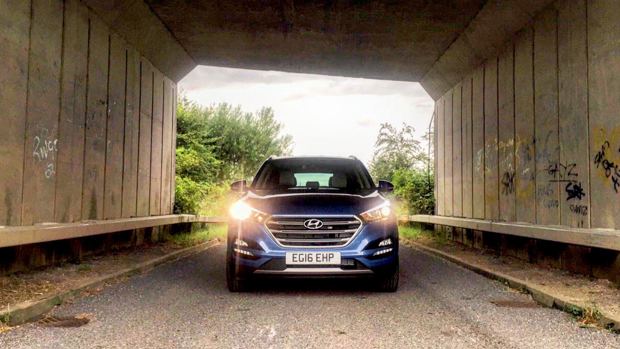
Date: 29 August 2016 | Current mileage: 3305 | Claimed economy: 47.9mpg | Actual economy: 42.1mpg
There's a 69PS gap in power between our Hyundai Tuscon's 185PS 2.0 CRDi diesel engine and the entry-level 1.7 CRDi. So do we really need all those extra horses (or 'pferde' in the German PS)?
Perhaps some context is needed to illustrate just how much 185PS is in a car this size. When modern SUVs were introduced as alternatives to traditional family cars in the mid-1990s, they were led by the Toyota RAV4, Honda CR-V and Land Rover Freelander. Only the Freelander was offered with a diesel engine at the time, and it was a 101PS 2.0-litre L-Series from Rover Group, which lived on into the MG Rover era.
Successive generations of the Freelander included new diesel engines, with power reaching 116PS and 156PS, while when larger premium SUVs arrived in the late 1990s, even their diesel engines look a little under-powered compared with our Tucson. The first diesel Mercedes-Benz M-Class used a five-cylinder 2.7-litre engine, producing 163PS, and the first diesel BMW X5 was powered by a 184PS 3.0-litre six-cylinder motor. Even the 2002 Range Rover diesel could only muster 174PS, using a version of the engine in the BMW X5.
The Tucson fitted with the 116PS 1.7 CRDi is only available with front-wheel drive and comes with the company's Blue Drive badge, which signifies best-in-range fuel efficiency. And that version offers a maximum towing capacity of 1400kg. Both 2.0 CRDi variants, which come with all-wheel drive as standard, have a maximum towing weight of 2200kg - a difference of 800kg, which is almost as heavy as some small cars.
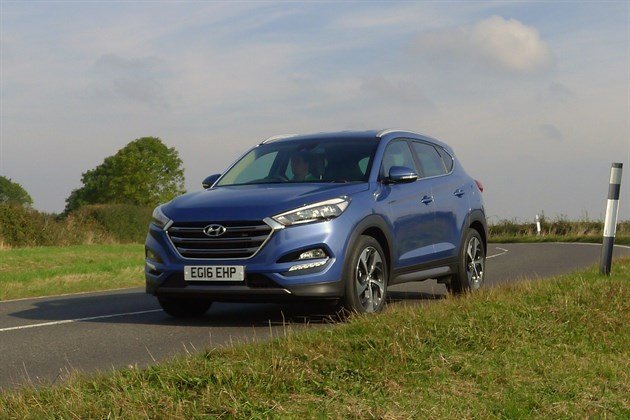
Our Tucson is fitted with the most powerful engine options
The larger engine brings a boost in pulling power, which customers will notice in acceleration. The 1.7 CRDi has maximum torque of 280Nm, and the manual version will accelerate from 0-62mph in 13.7 seconds. The 136PS 2.0 CRDi has 373Nm of torque, and hits 62mph in 10.9 seconds, while our 185PS car has a 0-62mph time of 9.9 seconds.
This is perhaps not quite as fast as you might expect for a 185PS car, which also demonstrates how much more important torque is for acceleration times, and on the road it doesn't feel particularly quick. Of course, it's plenty responsive enough for safe overtaking when encountering a slower vehicles, but occupants are never at risk of being pinned back in their seats.
One of the factors that has allowed this steep increase in power outputs for SUVs is the vast improvements in on-road behaviour. An SUV of this size 20 years ago would have been terrifying to drive with an engine this powerful, because the road holding and body control was nowhere near the standards customers expect today.
The Hyundai feels comfortable being hurried along on country lanes, with no excessive leaning in corners, and all that power in reserve helps make it feel more relaxed in these conditions. The Tucson 2.0 CRDi has a greater breadth of abilities than the 1.7 CRDi, which for me makes it preferable.
Safe space
Modern cars are becoming increasingly safe, but how much do you have to pay to be protected?
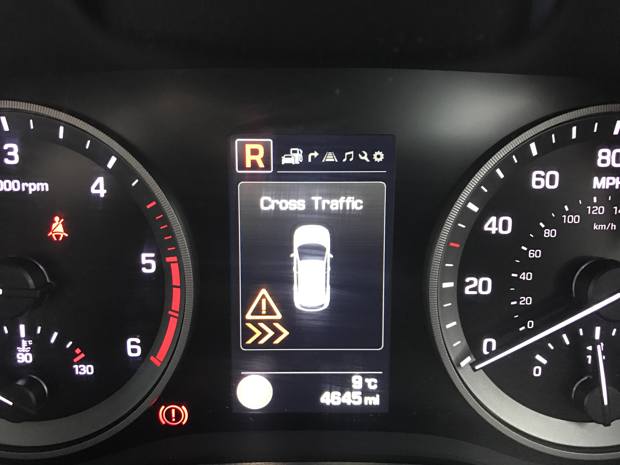
Date: 16 September 2016 | Current mileage: 4193 | Claimed economy: 47.9mpg | Actual economy: 42.1mpg
How much we are prepared to pay extra for safety equipment in cars depends on how much we think we're going to need it. If you have a family with young children, you might be more likely to consider specifying optional safety equipment in a new car, or choosing a car with the best possible crash test ratings in its class.
If you have a low accident record and rarely take passengers, you might be less likely to tick the optons box for preventative safety gadgets, which can add hundreds, or maybe thousands of pounds to the cost of a new car.
The car I was testing before the Hyundai Tucson offered a safety equipment pack, but only on the highest equipment grade. It wasn't available as an option elsewhere in the range even as an option. This meant if you wanted all the safety features available you were choosing a £41,000 car.
One of the great features with the Tucson, which for many will be the main family car, is that on our mid-grade premium model, many safety features that would be optional on some cars come as standard.
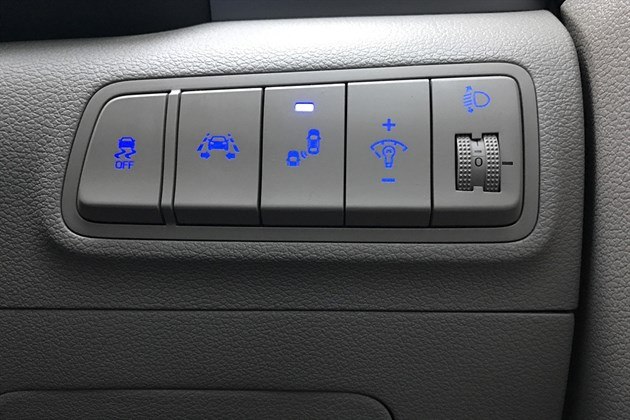
No blank buttons here
All Tucsons come with electronic stability control, hill-start assistance and downhill braking control, while all except the entry-level S have lane departure alert with an assistance function that helps steer the car to prevent it from inadvertently crossing the lane.
But the Premuim grade adds a blindspot warning, autonomous emergency braking (which can hep reduce insurance premiums) and rear cross traffic alert. The latter is designed for those who park front-in in car parks, and sensors at the rear of the car look out for approaching traffic when reverse in engaged.
It results in an audible alert and a warning in the centre of the instrument display, showing the direction the approaching traffic is coming from. It is quite fashionable among those of us who write about cars to scoff at some of these features and lament the fact that they take responsibility for observation and safe driving away from the person behind the wheel.
I would argue that this is nonsense. They are designed to back us up on the rare occasions where a momentary lapse of concentration or a sudden distraction could result in damage to the car or other vehicles, as well as injury to occupants or other road users. And Hyundai should be applauded for democratising safety in this way, and hope other manufacturers who expect you to pay extra for these items take note.
Peace of mind
The Tucson is available with an unlimited mileage warranty. Could this boost its chances as a company car?
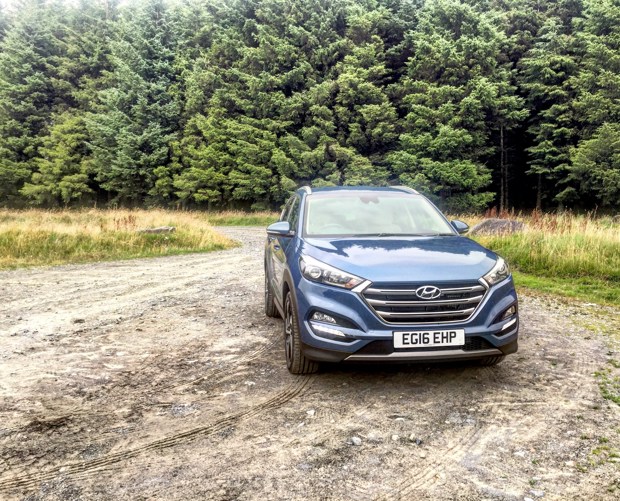
Date: 3 October 2016 | Current mileage: 4427 | Claimed economy: 47.9mpg | Actual economy: 41.9mpg
Can a long warranty contribute to lower running costs? It probably can, and perhaps the Tucson is perhaps a good illustration.
It’s 14 years since Hyundai set a new benchmark for new vehicle warranties in the UK. It decided to shift from three years/60,000 miles to five years/unlimited mileage as a way of demonstrating its faith in the latest generation of cars.
By the time of Hyundai’s October 2002 announcement, it had only been two years since three years/60,000 miles had been regarded as typical, with Ford’s decision to shift from 12 months/20,000 miles at the 2000 British International Motor Show sparking an industry-wide move among those who hadn’t already provided a three-year warranty.
It results in peace of mind for customers should something serious go wrong with the car during the warranty period, and if people only keep their cars for three or four years, they can be sold to the next owner with a period of manufacturer-backed cover. For people who perhaps have a Hyundai company car and cover high mileage, it means that even if they cover more than 20,000 mile a year, the warranty remains intact during the five-year period.
Of course, there are other factors that come into play when it comes to the desirability of a used car. But for the sake of argument, lets look at the Tucson with a similarly priced version of the sector favourite, the Nissan Qashqai.
Our Tucson – a 185PS all-wheel drive diesel priced at just over £29,000 new – versus a 130PS Qashqai 1.6 dCi AWD Tekna, also slightly north of £29,000 on-the-road in price lists.
According to running costs provider KeeResources KwikCarCost, the Nissan would be worth £9325 at three years and 60,000 miles, the point when its manufacturer warranty expires. Compare that with the Tucson’s £11,100 at the same point, and with two years’ warranty left regardless of future mileage, and perhaps it isn’t difficult to see why the Hyundai might be a more attractive used car.
It will be interesting to see if the Tucson maintains its used value lead as it becomes an older car, and, of course, the sheer volume of Nissan Qashqais on the road means there are plenty for people to choose from. But it illustrates how what was once thought of as a budget brand is now readily accepted as having more valuable used cars than firmly established meainstream models.
Over-navigating but under-delivering?
The Tucson in Premium grade comes with a standard touch-screen navigation system. How does it perform?
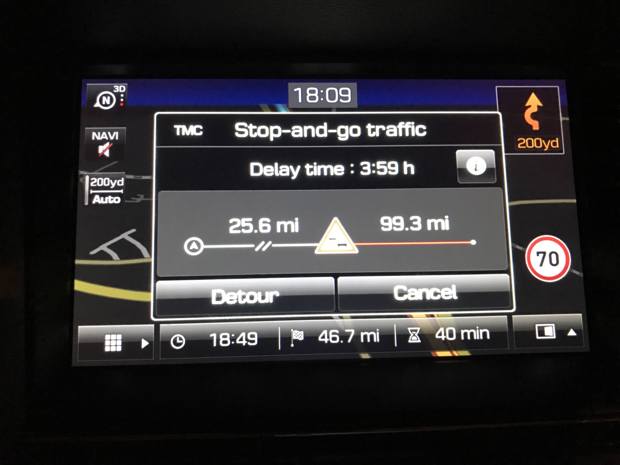
Date: 21 October 2016 | Current mileage: 4832 | Claimed economy: 47.9mpg | Actual economy: 42.6mpg
The Hyundai Tucson comes with a touch-screen navigation system as standard when you choose Premium or Premium SE grade. It’s good that customers choosing a medium grade car don’t have to pay extra for integrated sat-nav.
It might be true that portable navigation systems becoming more affordable have, to many people, made the idea of paying for an optional factory-fitted sat-nav redundant. Some will, however, prefer the security of the screen mounted in the dashboard over having to remember to take the portable navigation system out of the car.
The system in the Tucson, which, of course isn’t unique to the Tucson, or even Hyundai, is quite sophisticated. You can select a destination by address or postcode, or if it’s a ‘point of interest’ by name or by category. You can also choose where to go by dropping a pin on the map by touching a particular point.
The next step involves the system calculating three route options: fastest, shortest and ‘eco’. Usually I select the fastest route, as I’m always in a terrible hurry, and soon after setting off the screen will show alerts of congestion along my route.
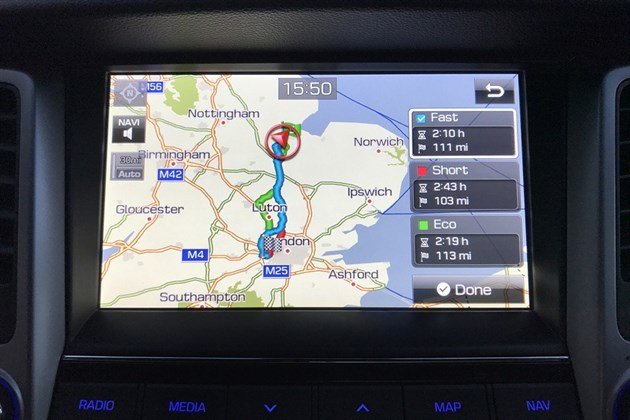
Fast, short, eco... I'll take fast please
My understanding is the fastest route is calculated by the speed limit signs on that particular course, resulting in a shorter journey time. But the real-time congestion data requires driver intervention to change course.
Sometimes I’m prompted to choose an alternative route even with a minute’s delay caused by stop/start traffic over 100 yards. And often, if you select the detour option, the system can’t decide for itself whether a 30-minute longer journey on a new route is better than a 15-minute delay caused by congestion on the existing setting.
This is an area where portable navigation systems, and apps such as Google Maps or Waze have an advantage over factory-fitted navigation, and we’re already seeing some cars becoming more compatible with smartphone apps for navigation through MirrorLink, Android Auto and Apple CarPlay.
Of course, if you’re keen on saving fuel and aren’t too worried about the time of arrival, there’s always the ‘eco’ route.
Economic upturn
Real MPG says cars don't achieve the official figures in real life. But the Tucson is getting very close.
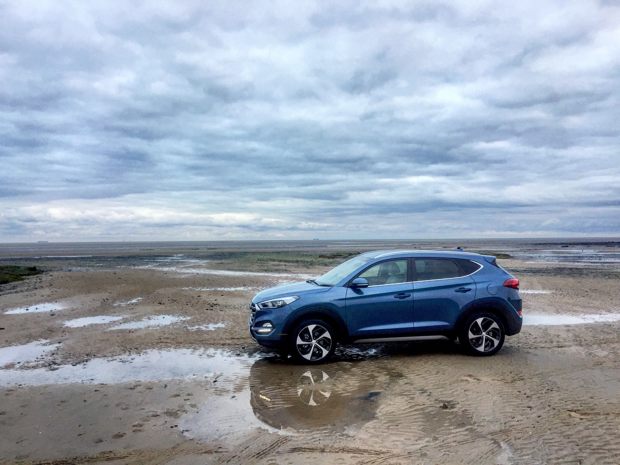
Date: 10 November 2016 | Current mileage: 5281 | Claimed economy: 47.9mpg | Actual economy: 44.9mpg
Regular users of this website will know there is often a huge disparity between the fuel economy figures we achieve in day-to-day running of our cars, and those that have long been assumed to be the ‘average’ published by the car manufacturer. Our Real MPG figures – average fuel economy figures provided by you, our readers – are a more realistic guide under the current system.
Many of you probably won’t know that the figures published by manufacturers were taken on a rolling road on a seven-mile route simulating different driving conditions. Readings are taken on the ‘urban cycle’ – meant to reproduce typical low-speed driving around town – and the ‘extra-urban cycle’ – recreating out-of-town driving at higher speeds.
From that, a calculation is made to reach the ‘combined cycle’ – an average of both. So, as well as being conducted in lab conditions, the figure that we have trusted as typical for the vehicle is actually a calculation. A hypothetical.
And as car manufacturers have been keen to reduce CO2 emissions Europe-wide under the official test cycle, to ensure their ranges meet a target average or face fines imposed by the EU, perhaps it’s unsurprising that the figures we achieve in the real world are becoming ever distant from what we see in the brochures. CO2 readings broadly correspond with the amount of fuel burnt in the engine.
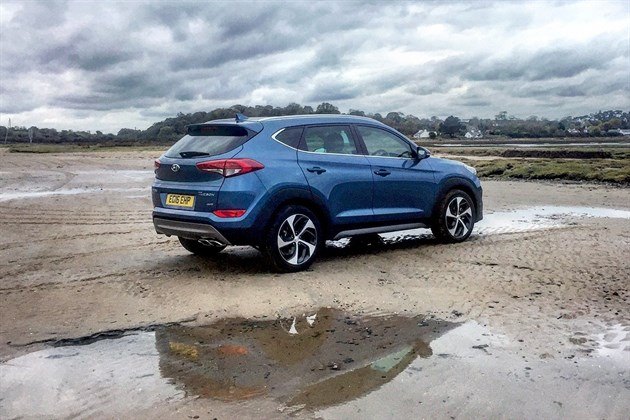
Sand isn't the best surface for eco driving
But a recent few stints behind the wheel of the Tucson, which were mainly motorway-based, saw the trip computer threaten to match to official figure for the first time. Of course, exceeding the motorway speed limit is out of the questions, although so many people now accept 80mph or more as the norm, forgetting they could be burning as much as 20 per cent more fuel than at 70mph.
And some of the motorways I had been using had speed restricted areas with average speed cameras at 50mph, which meant quite a few miles operating very efficiently at low revs in sixth gear. At one point, the trip computer crept up to 46.0mpg, just 1.1mpg away from the combined cycle figure for this version of the Tucson.
Ultimately, a few periods of driving around town took their toll on the figure, bringing it down to an indicated 44.5mpg by the time I refuelled, but still the highest recorded for my 4000 or so miles with the car. And after brimming it at refuelling, the actual fuel economy figure worked out at 44.9mpg. Could it be that the car’s trip computer was even reading a little pessimistically?
Of course, road conditions and smooth driving dictate what fuel consumption we achieve, and with winter approaching, we might not see such a high figure before the Tuscon’s time with us is finished. However, with heated front seats as standard and on-demand four-wheel drive, there aren’t too many better cars in which to be heading into winter.
Going abroad
The Tucson has been abroad for Christmas, and we look at some of the extra equipment you have to carry when driving overseas.
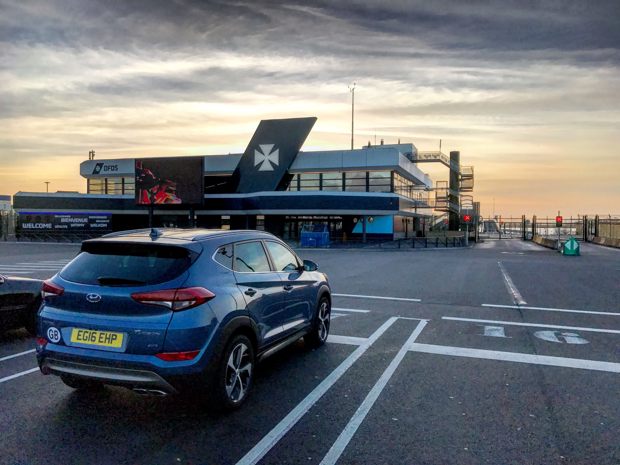
Date: 29 December 2016 | Current mileage: 6418 | Claimed economy: 47.9mpg | Actual economy: 42.5mpg
There are plenty of popular holiday destinations in the UK, but some of us like to travel abroad and take our cars, whether towing a caravan, seeking out a secluded area in the south of France or a winter-ready 4x4 heading to an Alpine ski resort. But most cars are rarely ready to be driven overseas without preparation beyond the usual routine for ensuring the car can take a long trip in its stride.
I spent Christmas 2016 abroad and took the Tucson, having to ensure I carried additional equipment, including a breathalyser (compulsory in France), spare bulbs, high-visibility vest, and warning triangle (in case of breakdowns). Some cars have sophisticated headlamps that can be simply adjusted to driving on the right, sometimes possible automatically from the GPS detecting its location.
However, for the Tucson, some trusty deflector stickers were applied to the clear-lens headlights, the edges aligning with the centre of the projector lamp. Some car registration plates have the country of origin displayed on the left, but our Tucson doesn’t. And it has become common to find removable magnetic GB labels to fix to the rear of the car.
But these are becoming obsolete as so many new cars no longer use steel in the rear bodywork. We resorted to the old-fashioned self-adhesive sticker and headed to the Port of Dover for a ferry crossing with DFDS to Dunkirk. My final destination was in the Netherlands, so the extra 30 minutes to less busy Dunkirk instead of Calais was welcome, and also meant a slightly longer break from being behind the wheel.
The Tucson's dashboard screen displays info on speed limits for countries abroad in mph
In a previous update I criticised some aspects of the Tucson’s satellite navigation system, specifically its over-cautious attitude toward traffic disruption hours ahead on the route. When I reached France, the screen showed some unexpected and useful information.
The Tucson Premium has a camera that reads speed limit and certain other traffic signs, and displays the speed limit in the instrument panel, as well as on the dashboard screen. When crossing a border, the dashboard screen showed the telephone code for the new country, the main speed limits for motorways, out-of-town roads and urban areas, as well as whether there is data supplied to the traffic management channel.
Perhaps the most surprising feature was its ability to read foreign traffic signs in kmh, but display the reminders on the dashboard and in the instrument panel in mph – the same as the main calibration for the speedometer.
Joined up thinking like this has helped elevate the image of Hyundai from its former status as a budget brand, to not only become part of the mainstream, but also show the company is capable of a level of sophistication and intuitiveness that is more commonly found in premium-brand cars.
Buying online now an option
Hyundai has launched a service that means you can buy a Tucson online rather than engage with a new car dealer. Is this the future?
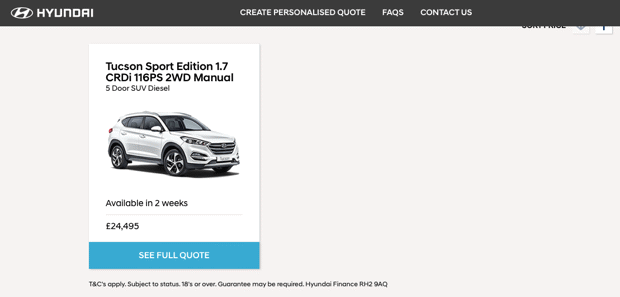
Date: 23 January 2017 | Current mileage: 7410 | Claimed economy: 47.9mpg | Actual economy: 44.0mpg
If you’ve been buying new cars for many years, it’s likely that your buying and decision making process has changed dramatically in the last couple of decades. Far more of your research is completed online comparing deals, prices and specifications rather than visiting dealers and poring through printed brochures.
We never used to buy cars this way. It was a long, and sometimes laborious process, visiting dealers to collect brochures and talk through some of the cars available, then deciding on the type of car you wanted then comparing offers between different dealers. But we now buy so many of our other goods online, then why not cars?
At the end of 2016, Hyundai announced a new ‘Click to Buy’ service, allowing customers to research their choices, agree a part-exchange value for their current car, and buy a new Hyundai at a discount online, having the car delivered to them if desired, removing the dealer completely from the process.
Currently, at least, the Tucson we’ve been running isn’t included in the Click to Buy price list. Although representatives of most models in the Hyundai range are present. The Tucson on offer through Click to Buy is the 1.7 CRDi Sport Edition, and it’s priced at £1,000 lower than in the dealer price list.
The Tucson can be bought online without the customer having to visit a dealer
The customers feel like they are getting better value, achieving a discount without haggling, and, as the cars are available for delivery within two weeks, it is based on what Hyundai currently has in stock in the UK.
Hyundai is the first mainstream car manufacturer to announce such a scheme, although others have followed in the weeks since. Customers who pay with cash can elect to collect their car from a local dealer, while those using finance will need to visit the dealer beforehand to complete the paperwork.
But it could be the start of a transformation in how we view the car-buying process, and would certainly appeal to a new generation of car buyers who are used to buying other products online. And it’s another important area (following the launch of its five years/unlimited mileage warranty in 2002, and the launch of the first production hydrogen fuel cell car in 2015) where Hyundai is taking a lead rather than following.
The next few weeks will be the last we spend with the Tucson, which continues to perform dutifully averaging around 44mpg, its heated seats (standard front and rear) keeping our the winter chills, and its safety features insuring it keeps its driver out of trouble for its remaining time with Honest John.
Climb every mountain, ford every stream
The Tucson has served its time admirably on our test fleet, taking every challenge in its stride, and we're sad to see it go.
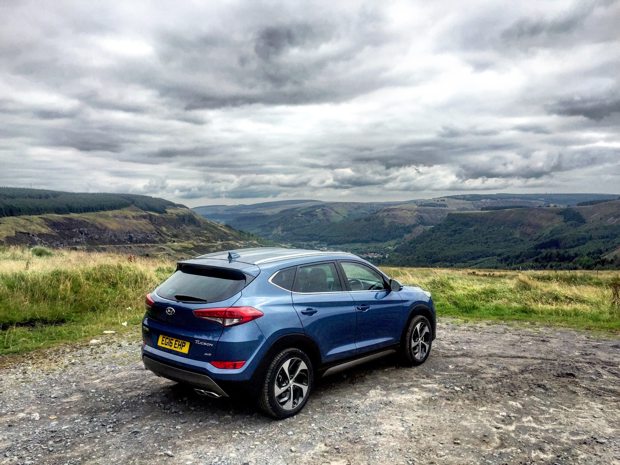
Date: 23 February 2017 | Current mileage: 10,350 | Claimed economy: 47.9mpg | Actual economy: 42.5mpg
The growth of ‘crossover’ and SUV sales does not show signs of slowing, and perhaps it’s the case that once people have chosen one and got used to the benefits over a traditional family hatchback, they never go back.
It’s an appeal I can understand after almost seven months with our Tucson. Although there are now large numbers of SUVs and crossovers on our roads, and the elevated driving position they offer is perhaps less of an advantage than it once was, it still contributes to a more relaxed driving experience and is often easier for getting in and out of the car. Long motorway trips have been dispatched with ease, and performance and comfort of the 185PS 2.0-litre diesel has also been a great advantage.
The relatively compact footprint of the Tucson – almost 30cm shorter than an i40, and only slightly longer than an i30 – makes it manageable in an urban environment. And the collision warning, that alerts the driver when the closing speed to the slower or stopped vehicle ahead risks a crash and needs extra pressure on the brake pedal, has meant the autonomous emergency braking has never been troubled.
The Tucson’s safety features have many other ways of taking the stress out of driving. I prefer to keep the lane-keeping assistance switched off, as the interference with the steering wheel at speeds high enough for it to activate feel a bit nannying, and when the lane departure warning chimes up, it can be slightly irritating. But the blindspot alert and the rear cross traffic alert effectively give you an extra set of eyes to monitor areas outside the driver’s immediate line of vision.The Tucson does its bit to show it's capable off road
The four-wheel drive system, available on 2.0-litre versions of the Tucson, also enables the Tucson to venture to areas away from roads, and while it has a part-time 4WD system that diverts torque to the rear wheels only when sensors detect the front wheels losing traction, there is a lockable centre differential to help get it out of particularly slippery situations. Like most owners, we didn't ask too much of the Tucson in frequently subjecting it to these conditions, but it did occasionally end up off-road for the purposes of our photos.
What didn't we like? The navigation system (standard on the Premium grade) looks good and generally performs well enough, but we didn't like it warning us of traffic and offering us a diversion than took longer than the anticipated delay in our original route. And while the interior looks good, there are perhaps still a few too many use of hard plastics, while other Hyundai models, such as the Santa Fe and the new i30, offer a more upmarket feel with more use of soft-touch materials.
We weren't disappointed with fuel economy. The Tucson proved capable of achieving the official combined fuel economy figure on a few occasions with light traffic in out-of-town roads, and typically achieved MPG in the low-to mid-40s - usually within 10 per cent of the official combined figure. Occasionaly it dipped into the high-30s with a lot of driving around town, but this is to be expected.
With a long warranty( five years/unlimited mileage), and Hyundai's keen finance deals, its not difficult to see the Tucson's appeal in a sector that is becoming highly competitive with models such as the Nissan Qashqai - the car that started it all in 2007 - and the Ford Kuga. But with talented new entrants like the SEAT Ateca and Peugeot 3008, Hyundai can't afford to lose focus.

